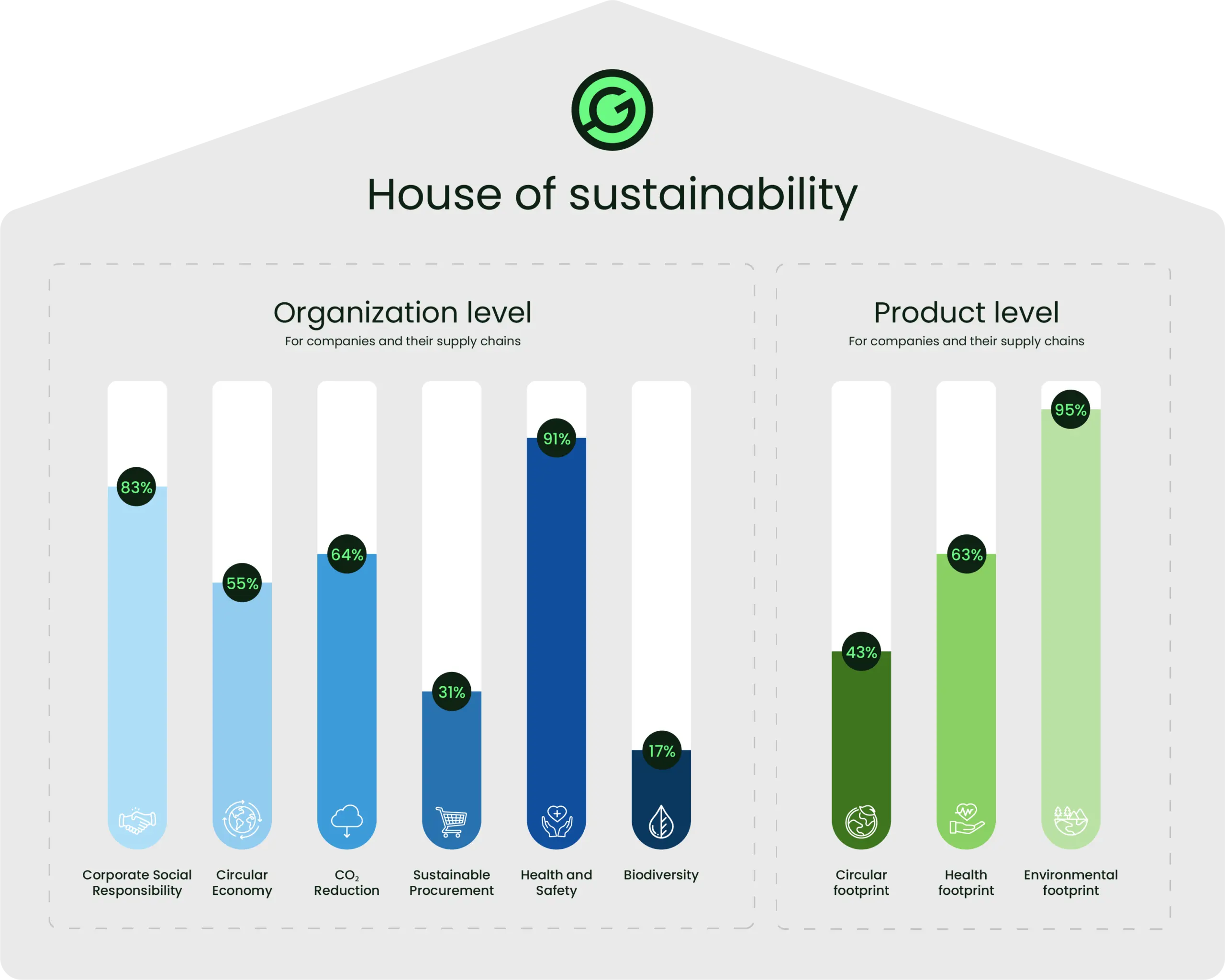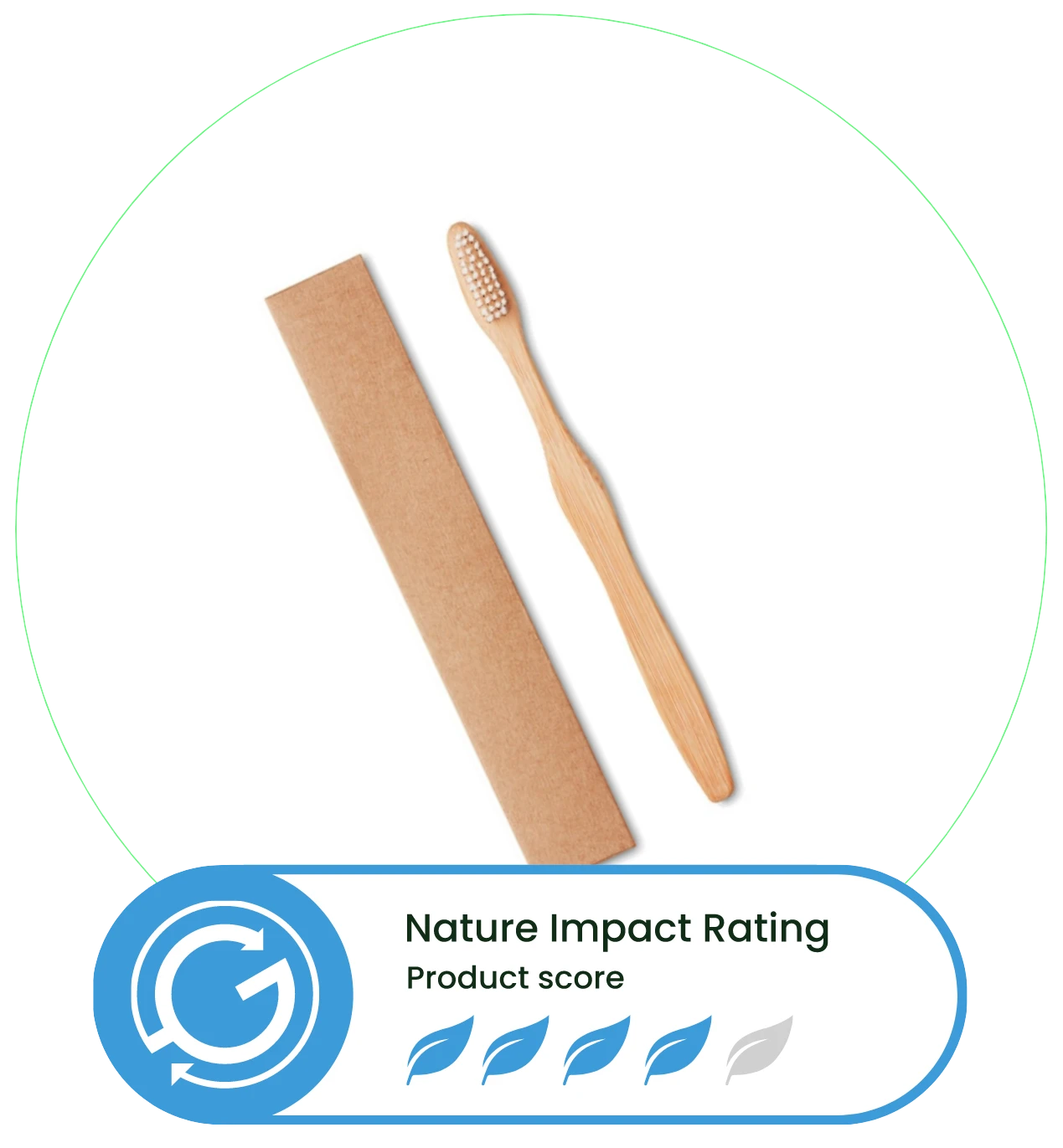Nature Impact Rating
The Nature Impact Rating evaluates a product’s sustainability across circular, environmental, social, and health footprints.
Certified products receive a rating, displayed as zero to five blue leaves, including an average score and detailed data for each footprint.
Display this scorecard publicly, integrate it into web shops, and easily compare sustainability across industries, all with credibility ensured by independent verification.
Key Features:

Universal comparability:
Easily compare sustainability across industries.

Public database:
Connect suppliers and retailers seamlessly.

Webshop integration:
Integrate effortlessly via API for streamlined processes.

Automated assessments:
Enjoy efficiency with automated digital evaluations.

Data integration:
Incorporate existing LCA/EPD data or Bills of Materials.

Third-party verification:
Ensure credibility with independent auditor verification.
Based on international standards, GSES has developed it’s house of sustainability

Responsibility
Economy
Reduction
Procurement
Safety
Footprint
Footprint
Footprint
The GSES benchmark translates ± 500 international ESG certificates into underlying KPI’s and makes them clear and therefore comparable! Organizations or products without certificates can perform assessments to demonstrate sustainability performance on the same benchmark.
How it works
The Nature Impact Rating averages a product’s circular, environmental, health, and social footprints to provide a clear picture of its sustainability. This holistic approach helps stakeholders understand the broader impacts of a product’s lifecycle on the environment and society.
The Circular Footprint measures a product’s material circularity, using principles from standards such as the Ellen MacArthur Foundation’s Material Circularity Indicator, Cradle to Cradle’s Material Reutilization Ratio, and the Dutch Green Building Council’s Disassembly Potential method.
The Health Footprint assesses toxic and hazardous substances in products and during manufacturing, aligning with REACH and other leading EU regulations on chemical safety.
The Environmental Footprint evaluates the environmental impact of manufacturing and supply chains, following LCA standards such as ISO 14040, ISO 14044 and PE.
Benchmark your progress and outperform competitors
Product scorecard
What? Recycled content is the percentage of the materials used in a product that have been diverted from the solid pre-and post consumer waste stream(s). Sourcing secondary materials (materials from recycled content) signifies a tangible commitment to diverting materials from landfills and reducing resource depletion. Three processes are combined under the umbrella term, ‘recycled’: recycling, reuse, and refining (chemical recycling).
Why? Incorporating recycled materials into products not only conserves natural resources but also reduces energy consumption and greenhouse gas emissions associated with virgin material extraction and processing.
What? Recycled content is the percentage of the materials used in a product that are biobased. Biobased materials are materials of biological origin excluding material embedded in geological formations or transformed to fossilized material and excluding peat.
Why? Biobased materials, derived from renewable biomass sources, offer sustainable alternatives to conventional fossil-based products.
What? Recycled content is the percentage of the materials used in a product that is actually compostable. A material is compostable if it decomposes under certain conditions in a short period of time, usually a few months, and provides nutrients to ecosystems in the process. The data used to determine compostability is based on European statistical databases or peer-reviewed literature and refer to actual rates of composting of specific waste materials.
Why? Embracing compostability promotes circular nutrient cycles, supports organic waste diversion from landfills, reduces methane emissions, and fosters sustainable agricultural practices.
What? The recyclable content indicator illustrates the extent to which a product or its components undergo circular processing after their use phase. The data used to determine recyclability is based on European statistical databases or peer-reviewed literature and refer to actual rates of recycling of specific waste materials.
Why? Recyclable content promotes the circular economy by facilitating the recovery and reuse of materials at the end of their useful life. Designing products with recyclability in mind encourages resource conservation, waste reduction, and the development of efficient recycling infrastructure to close material loops effectively.
What? Based on the Cradle to Cradle definition, easily separable means the ability of someone from the general public able to remove one homogeneous material from another one it is physically attached to using common tools (e.g., hammer, screwdriver, pliers) with minimal technical experience and instruction.
Why? A product that is easily separable enhances the feasibility of circular economy initiatives by enabling the recovery and reuse of valuable materials which facilitates efficient recycling and waste management processes thus reducing environmental burden and promoting resource conservation.
The detachability index, derived from the Disassembly Potential Measurement method of the Dutch Green Building Council (DGBC), only applies to building products. It assesses a product’s inherent potential for separability, considering connections based on their detachability and evaluates the ease of accessing connections without causing damage to surrounding structures. The resulting Detachability Index (DI), ranging from 0% to 100%, determines disassembly potential and a score exceeding 50% results in the full 5% for the separability indicator of the circular footprint.
What? A guarantee by the manufacturer of at least 3 years which is 1 year longer than required by EU regulations.
Why? Knowing that a product offers an Extended Warranty assures consumers of its durability and reliability, increasing confidence in its long-term value and reducing concerns about potential repair or replacement costs.
What? Consumer packaging that does not contain any plastic materials, such as (and not limited to) PP, PE, PS, PET, ABS, EVA, PVC, PVE, etc.
Why? Plastic-free packaging reduces plastic pollution, aligns with sustainable packaging practices, and reduces negative environmental impacts.
What? Consumer packaging that contains at least 95% recycled materials.
Why? High recycled content packaging minimizes resource consumption, lower carbon footprint, and promotes a circular economy contributing to waste reduction efforts.
What? Climate change is the indication of potential global warming resulting from emissions of greenhouse gasses into the air from three categories: emissions from fossil resources, bio-based resources, and land use change activities. It provides a comprehensive overview of the sources contributing to climate change, aiding in targeted mitigation strategies and policy formulation. The data comes from Life Cycle Inventory Databases and is secondary and global in nature.
Why? Tracking greenhouse gas emissions is vital as it provides a clear understanding of a product’s contribution to climate change and can assist in a reduction of the product’s environmental impacts and mitigate global warming.
What? Acidification potential measures the capacity of emissions of nitrogen oxides and sulfur oxides to contribute to acidification of soils and water bodies thus harming ecosystems and human health. The data comes from Life Cycle Inventory Databases and is secondary and global in nature.
Why? Tracking the acidification potential of products is essential as it quantifies the emissions that contribute to impacting ecosystems and human health.
What? Primary non-renewable energy consumption expressed as MJ per functional unit, encompasses the energy required for resource extraction and manufacturing processes. The data comes from Life Cycle Inventory Databases and is secondary and global in nature.
Why? Tracking primary non-renewable energy consumption provides insights into a product’s environmental footprint, helps mitigate reliance on finite energy sources, and reduces the associated environmental impacts such as greenhouse gas emissions.
What? Freshwater use assessment evaluates the environmental consequences of water consumption, including its subsequent effect on water availability for humans and ecosystems, impact on ecosystems, and quality. Understanding freshwater use enables responsible water management practices that balance human needs with ecological sustainability. The data comes from Life Cycle Inventory Databases and is secondary and global in nature.
Why? Assesses the environmental impact of water consumption on both human needs and ecosystems works towards ensuring sustainable water management practices that prioritize ecological health and resource conservation.
What? REACH, a regulation established by the European Union, aims to enhance protection of human health and the environment by mitigating risks associated with chemicals. It also seeks to boost competitiveness within the EU chemicals industry by encouraging the adoption of alternative, less harmful chemicals. This indicator shows whether the manufacturer has signed a declaration that their product is in compliance by containing less than 0.1% by weight any substances in the list of SVHC.
Why? By guaranteeing that products meet stringent safety standards and minimize risks associated with hazardous substances it leads to protecting human health and the environment.
What? The Additional Declarations are based on the Restricted Substances List of the Cradle to Cradle standard. Cradle to Cradle has put together a list of relevant regulations, globally, that restrict or ban the use of certain substances. This indicator is used to go beyond REACH and consider a wider range of product-specific and non-specific regulations, with a global reach.
Why? Having a global and more encompassing health safety declaration ensures that there is a comprehensive overview of the health impacts of a product.
What? Assessing human toxicity for cancer considers the potential health risks associated with exposure to toxic substances that were released into the air, water, or land. Human toxicity is calculated using a combination of factors considering emissions of various chemicals throughout the life cycle stages of products including environmental fate factor, human exposure factor, human toxicity effect factor, toxicity-effect damage factor. The data comes from Life Cycle Inventory Databases and is secondary and global in nature.
Why? By identifying and mitigating carcinogenic hazards, organizations can safeguard human health and advance product safety and sustainability.
What? Human toxicity assessment for non-cancer effects evaluates the adverse health impacts of exposure to toxic substances through inhalation of air, food/water ingestion, penetration through the skin, excluding carcinogenic effects. Understanding and addressing non-cancer toxicity risks promotes product safety, regulatory compliance, and public health protection. The data comes from Life Cycle Inventory Databases and is secondary and global in nature.
Why? Assessing human toxicity beyond cancer risks aids in understanding the broader health impacts of substances, informing risk management strategies to minimize adverse effects on human health and ensure the safety of products throughout their lifecycle.
What? Ecotoxicity assessment evaluates the ecological risks posed by chemical emissions to nonhuman organisms and ecosystems. Expressed as comparative toxic units (CTUe), it offers an estimation of the proportion of species potentially impacted over time and volume per unit mass of emitted chemical. By quantifying potential impacts and identifying environmentally sensitive areas, ecotoxicity assessments inform pollution prevention measures and ecosystem conservation efforts. The data comes from Life Cycle Inventory Databases and is secondary and global in nature.
Why? Evaluating ecotoxicity is crucial for assessing the potential harm of substances to ecosystems and wildlife, minimize environmental degradation, and preserve biodiversity for present and future generations.
What? The carbon footprint of packaging quantifies the climate change impacts of the consumer packaging materials from cradle to gate.
Why? By optimizing packaging design and materials selection, companies can minimize carbon emissions and contribute to a more sustainable packaging system.
What? Transportation data specifically accounts for product movement from manufacturing to point of sale, excluding sub-components and packaging points, with distances calculated from the production site gate to an average retailer or distribution platform. Transportation values entered on the GSES platform, whether through LCA or Material Index methods, affect the environmental and health indicators. Omitting the transportation data results in a 4% reduction in the overall NIR score.
Why? Longer distances traveled lead to higher energy consumption and greenhouse gas emissions for products. Incorporating transportation data allows for a comprehensive cradle to market understanding of the environmental and health impact of a product and empowering consumers to make choices that minimize energy consumption, reduce emissions, and support sustainable transportation practices.
The Environmental Cost Indicator integrates diverse environmental impacts into a unified fiat currency, in Euros, facilitating decision-making towards sustainable solutions. By monetizing environmental costs, organizations can internalize externalities, prioritize resource-efficient practices, and promote sustainable development. The scope of the ECI calculation is cradle-to-gate. The factors used to calculate the ECI are the monetary impacts of the material on abiotic depletion, non fuel & fuel, global warming, ozone layer depletion, photochemical oxidation, acidification, eutrophication, ecotoxicity, freshwater, marine water & terrestrial and human toxicity, cancer & non-cancer. These prices are calculated from the Environmental Prices Handbook that is regularly updated and verified.
This indicator is specifically used for cosmetics products and cleaning agents in the Nature Impact Rating methodology. In cosmetics, ‘microplastic’ refers to all types of tiny plastics particles intentionally added to personal care & cosmetic product. Microplastics are a risk to human health and the environment, and microplastic pollution is irreversible. At the same time, it is difficult to come up with a precise definition of microplastics. The Nature Impact Rating uses the Plastic Soup Foundation’s Beat the Microbead App’s categorization of microplastics into Red, Orange and Green. Companies can either declare that the product contains no microplastics listed in the Red/Orange microplastics list (the product is then on the Green list). Alternatively, companies can show they have the “Zero Plastic Inside” certification which shows that the entire product range free of microplastics from the Red or Orange lists. These products are rewarded with 5% of the circular footprint score.
This indicator is specifically used for food products in the Nature Impact Rating. Products containing the EU Green Logo contain more than 95% organically grown ingredients which respect the highest standards for human, animal and environmental health in the process of farming the raw ingredients. Another acceptable certification is Demeter or EKO (Dutch only). These products are rewarded with 35% of the health footprint score.
The Nature Impact Rating for food and beverage products awards a score of 20% in the Health Footprint if the retailer or their supplier provide a signed declaration that the primary packaging for the food or beverage product is entirely free of Bisphenol A and PFAS. THe burden of proof is a signed declaration of compliance.
Roughly 33% of food is wasted along the chain. Companies should vigilantly track the wastage of food across its value chain to measure and understand the opportunities to reduce such wastage. The Food Loss and Waste (FLW) Protocol is the gold standard for how to calculate food waste. It also contains verification guidelines for these calculations. In the Nature Impact Rating, a retailer who is writing and publishing a third-party verified Food Loss and Waste report is rewarded with 20% of the Circular Footprint score.
This indicator of the Nature Impact Rating for Cosmetics checks for the retailer’s commitment to reducing the amount of unsold products that end up being destroyed (landfilled or incinerated). The policy plan should provide concrete actions and targets being taken to reduce and prevent the destruction of unsold products. For retailers that have such a policy in place, their products are rewarded with 15% of the circular footprint score.
Sustainability embodies the principle of meeting the needs of the present without compromising the ability of future generations to meet their own needs. It emphasizes responsible resource management, environmental stewardship, and social equity to ensure a balanced and thriving world for all. Our definition of sustainability is based on the definition used by ISO 26000 “Guidance on Social Responsibility.” For products, ‘sustainability’ can indicate lower footprints.
Life Cycle Assessment (LCA) serves as a comprehensive tool for evaluating the environmental impacts of products, services, companies, or processes across their entire life cycles. By considering factors such as raw material extraction, manufacturing, and distribution, LCA enables informed decision-making towards sustainable practices and resource optimization. LCAs are a standardized evaluation method based on ISO 14040 and ISO 14044.
At GSES, circular materials refer to materials that are biobased or sourced from recycled materials, and that can be recycled and composted after they have been disposed of. Embracing circularity reduces reliance on finite resources, minimizes waste generation, and fosters a closed-loop system that supports long-term environmental health.
